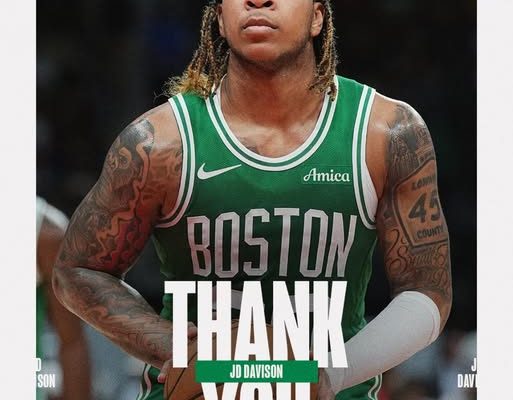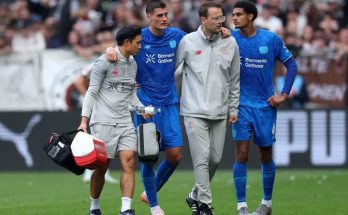The news rippled through the NBA world with a quiet, yet significant, thud: “Thank you, JD.” These three simple words, often uttered with genuine warmth and appreciation in the context of professional sports, took on a more complex, almost bittersweet, resonance when the Boston Celtics announced they were waiving G League MVP and 2024 NBA champion JD Davison. For many, it felt counterintuitive. How could a team part ways with a player who had just achieved such remarkable individual success in the developmental league and was a part of a championship-winning roster, especially one that had recently converted his two-way deal to a standard contract? The answer, as is often the case in the intricate world of the National Basketball Association, lies not just in on-court performance, but deeply rooted in the nuanced and often unforgiving landscape of the collective bargaining agreement, specifically the looming specter of the second apron.
To truly understand the implications of the Celtics’ decision to waive Davison, a move that cleared roughly $2.3 million and slipped them back under the second apron, we must first delve into the journey of JD Davison himself, and then, crucially, dissect the complexities of the NBA’s financial regulations, particularly the recently implemented second apron.
JD Davison’s story is a testament to perseverance and the often circuitous path to NBA relevance. Drafted 53rd overall in the 2022 NBA Draft by the Boston Celtics, Davison was initially signed to a two-way contract.1 This type of contract is designed to allow young players to split their time between an NBA team and its G League affiliate.2 It’s a vital tool for player development, offering a bridge between the demanding professional environment of the NBA and the competitive, yet slightly less pressurized, G League. For players like Davison, a two-way deal provides invaluable game experience and an opportunity to hone their skills against professional competition, without immediately taking up a valuable roster spot or significantly impacting the NBA team’s salary cap.
Davison embraced this opportunity with the Maine Celtics, Boston’s G League affiliate. His talent was undeniable, characterized by his explosive athleticism, quick first step, and impressive playmaking abilities. He quickly established himself as a dominant force in the G League, consistently showcasing flashes of the elite potential that had made him a highly touted recruit coming out of high school. His stat lines for the Maine Celtics were often eye-popping, filled with points, assists, and rebounds, demonstrating a well-rounded game that belied his young age.
The culmination of his G League efforts arrived in the 2024-25 season, when JD Davison was deservedly named the NBA G League Most Valuable Player. This award is not given lightly; it signifies a player who has demonstrated exceptional performance, leadership, and impact on their team’s success. Davison’s MVP season was a clear signal that he was outgrowing the G League and was ready for a more substantial role at the NBA level. It was a moment of triumph, a validation of his hard work and dedication.
Adding to his remarkable year, Davison was also a member of the Boston Celtics squad that captured the 2024 NBA Championship.3 While his minutes with the parent club were limited across his three-year, 36-game stint in Boston – averaging just 1.9 points, 0.9 assists, and 0.9 rebounds in approximately 5.5 minutes per contest – he was still an official part of the championship team. He contributed in practice, absorbed knowledge from veteran players, and experienced the intense atmosphere of an NBA playoff run, ultimately earning a championship ring. This experience, however brief his on-court appearances, is invaluable for a young player’s development and understanding of what it takes to win at the highest level.
Given his G League MVP honor and being a part of an NBA championship team, the Celtics’ decision to convert his two-way contract to a standard deal three months prior to his waiver seemed like a logical step. This move signaled the organization’s belief in his long-term potential and their intention to integrate him more fully into the NBA roster. A standard contract offers greater financial security for the player and implies a more committed investment from the team. It seemed as though Davison’s patient development was finally paying off, and he was on the cusp of a true breakthrough in Boston.
However, the celebratory glow of the championship and the promise of a standard contract were overshadowed by the cold, hard realities of the NBA’s financial structure, particularly the new Collective Bargaining Agreement (CBA) and its stricter luxury tax penalties, most notably the “second apron.”
To fully grasp why Davison was waived, we need a deep dive into the NBA’s salary cap and luxury tax system. The NBA operates under a “soft cap,” meaning teams can exceed the salary cap, but doing so incurs a luxury tax.4 This tax is a penalty teams pay for spending beyond a certain threshold, with the amount increasing progressively the further a team goes over. The purpose of the luxury tax is to promote competitive balance by disincentivizing excessive spending by wealthier teams.
The new CBA, which came into full effect for the 2024 offseason, introduced even more stringent measures, particularly with the addition of the “first apron” and “second apron.”5 These aprons are essentially higher spending thresholds above the luxury tax line, each with its own set of increasingly severe penalties and restrictions on team building.
Let’s break down these financial tiers for the 2025-26 season, keeping in mind that these figures are projections and can fluctuate slightly:
- Salary Cap: Approximately $154.6 million. This is the baseline amount teams can spend on player salaries without incurring any penalties.
- Luxury Tax Threshold: Approximately $187.9 million. Once a team’s total salary exceeds this number, they begin paying a luxury tax. The tax rate escalates for every $5 million a team is over this threshold. For example, a team $5 million over might pay $1.50 for every dollar, while a team $10 million over might pay $1.75 per dollar, and so on, with rates increasing by $0.50 for every additional $5 million. These penalties can quickly become incredibly punitive, especially for repeat offenders.
- First Apron: Approximately $195.9 million. Teams operating above the first apron face additional restrictions. For instance, they cannot use the Non-Taxpayer Mid-Level Exception (NTMLE) or the Bi-Annual Exception (BAE) to sign free agents. They also have more limited salary matching rules in trades (110% of outgoing salary instead of 125%). Furthermore, if they use certain exceptions (like the NTMLE or BAE), they become “hard-capped” at the first apron, meaning they cannot exceed that salary threshold for the entire season.
- Second Apron: Approximately $207.8 million. This is the most restrictive and impactful threshold, and it is the key to understanding the JD Davison waiver. Teams that exceed the second apron face all the penalties of the first apron, plus an even more severe set of restrictions. These include:
- Loss of key exceptions: Teams lose access to the Taxpayer Mid-Level Exception (TMLE) and cannot use trade exceptions created by combining multiple player salaries.6
- Trade limitations: They cannot aggregate contracts in trades (meaning they can only trade one player for one player in terms of salary matching, making it harder to acquire higher-salaried players). They also cannot send cash out in trades and cannot trade first-round picks that are seven years in the future.
- Draft pick penalties: Perhaps most impactful, if a team remains in the second apron for three out of five consecutive seasons, their first-round draft pick is automatically moved to the very end of the first round, regardless of their record. This is a massive disincentive for sustained high spending, as it directly impacts a team’s ability to acquire top-tier talent through the draft.
- Hard Cap: Similar to the first apron, using certain exceptions while above the second apron will hard-cap a team at that threshold.
- Loss of key exceptions: Teams lose access to the Taxpayer Mid-Level Exception (TMLE) and cannot use trade exceptions created by combining multiple player salaries.6
The Boston Celtics, fresh off an NBA championship, found themselves in a precarious financial position. Their success, built on a roster of highly paid stars and crucial role players, had pushed their total salary bill significantly high. While winning a championship is the ultimate goal, it often comes with a hefty price tag, particularly under the new CBA.
Prior to waiving Davison, the Celtics were reportedly hovering just above the second apron, or at least dangerously close to it, even after making other moves to shed salary. For instance, reports indicated that they had already traded away players like Jrue Holiday and Kristaps Porzingis (though these moves predate the JD Davison waiver in terms of this specific scenario, they highlight the Celtics’ ongoing efforts to manage their cap).7 Additionally, players like Luke Kornet became free agents and signed elsewhere, and there were even reports of Al Horford potentially signing with another team. These are all strategic maneuvers by the front office to bring down the overall payroll.
The decision to waive JD Davison, who was on a non-guaranteed deal worth approximately $2.27 million for the upcoming season, was a calculated move to ensure the Celtics slipped back under the second apron. Clearing roughly $2.3 million from their books was just enough to achieve this critical financial objective.
Why was it so important for the Celtics to get under the second apron, especially after winning a championship? The answer lies in the severe restrictions and penalties associated with it. Brad Stevens, the Celtics’ President of Basketball Operations, and the entire front office are undoubtedly focused on sustaining long-term competitiveness. Being above the second apron severely hampers a team’s ability to make roster adjustments, acquire talent, and build for the future.
Imagine a scenario where the Celtics needed to make a trade to address a weakness or acquire a key piece. If they were stuck above the second apron, their options would be dramatically limited. They couldn’t easily aggregate salaries, making it harder to trade for a higher-salaried player. They couldn’t send out cash to facilitate deals. Most importantly, the threat of losing future first-round picks due to repeated second-apron violations is a bullet that championship-contending teams simply cannot afford to take. Draft picks, especially first-rounders, are the lifeblood of sustainable success in the NBA, providing cost-controlled talent and valuable trade assets.
Furthermore, with key players like Jayson Tatum reportedly facing an extended absence due to injury (as suggested in some reports for the upcoming season), the Celtics might need flexibility to navigate an unforeseen challenge. Being under the second apron preserves essential tools for roster construction, such as access to the mid-level exception, which allows them to sign quality free agents even when over the cap.
The waiver of JD Davison, therefore, wasn’t a reflection of his talent or his G League MVP season. It was a cold, hard business decision driven by the complex economics of the NBA. It was about financial flexibility, long-term roster building, and avoiding the crippling penalties of the second apron. The approximately $2.3 million freed up by his waiver allowed the Celtics to breathe a sigh of relief and maintain their ability to make strategic moves in the future.
This move also highlights a broader trend in the NBA under the new CBA. Teams are becoming incredibly disciplined and strategic in managing their payrolls to avoid the punitive apron penalties. We are seeing more teams prioritize financial flexibility, even at the cost of parting ways with promising young talent. The era of simply outspending the competition without significant consequences is largely over.
For JD Davison, this is undoubtedly a setback, but it is by no means the end of his NBA journey. His G League MVP award is a powerful testament to his abilities. Teams across the league are constantly looking for talented young guards who can score, create, and contribute. Davison’s impressive G League statistics – averaging 25.1 points, 7.6 assists, and 5.6 rebounds in 30 games for the Maine Celtics in his MVP season – will certainly attract attention. He is no longer eligible for a two-way contract with the Celtics, but he could sign one elsewhere or compete for a standard roster spot with another organization. Many teams will see a 22-year-old guard with his athleticism, scoring touch, and playmaking potential as a valuable project. He may need to prove himself again, perhaps through another G League stint or a training camp battle, but his talent speaks for itself. The experience of being part of a championship team, even in a limited role, also adds a valuable dimension to his resume.
The open roster spot created by waiving Davison provides the Celtics with additional flexibility. While signing another player might put them back close to the second apron, it gives them options. They could bring in a veteran minimum player, potentially a specialist who fills a specific need, or they could keep the spot open for future trade flexibility. Given the reports of Jayson Tatum’s potential absence, having an open spot allows them to be reactive if a suitable player becomes available or if they need to convert a two-way player to a standard deal later in the season.
In conclusion, the story of JD Davison’s waiver is a compelling illustration of the modern NBA. It’s a narrative where individual achievement, like an MVP award, and team success, like an NBA championship, can intersect with the harsh realities of salary cap management and luxury tax implications. The Boston Celtics’ decision was not an indictment of Davison’s talent, but rather a calculated maneuver to navigate the increasingly complex financial landscape of the league. It was a move driven by a desire to preserve future flexibility and avoid severe penalties under the new CBA’s second apron. While it marks the end of Davison’s three-year stint in Boston, it undoubtedly opens a new chapter for him, one where his proven G League success should position him for another opportunity to make his mark in the NBA. And for fans, it serves as an important, albeit sometimes frustrating, reminder that the business of basketball often dictates personnel decisions in ways that transcend what happens purely on the court. “Thank you, JD” truly encapsulates the mixed emotions of a promising talent being let go, not for lack of skill, but for the intricate dance between competitive aspirations and financial realities in the highest echelons of professional basketball.



